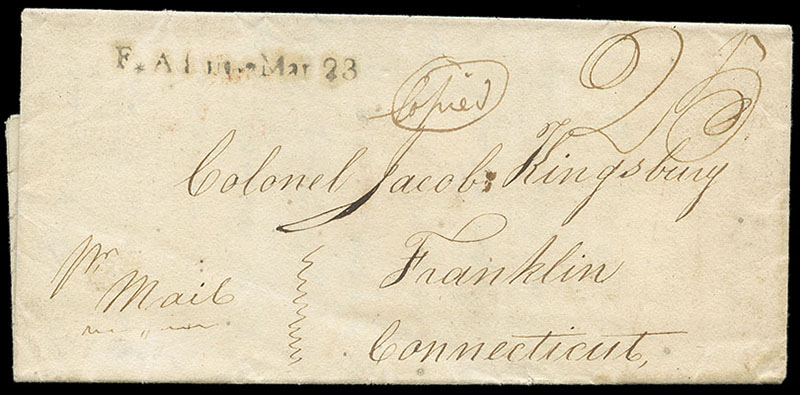
Lot
858 
"Camp Floyd, UT, Jan 14", manuscript postmark with matching manuscript cross-hatch cancelling 3¢ dull red (11A), rich color, on cover from the Porter correspondence to New York City, Very Fine and choice Utah Territorial use, ex-Risvold. Estimate $500 - 750.
On 9 November 1858, amid gun fire and patriotic music, the soldiers of Camp Floyd, Utah Territory, raised the United States flag above their newly completed garrison. Named for Secretary of War, John B. Floyd, the post housed the largest concentration of U.S. troops to that time, in what immediately became the third largest city in Utah. Camp Floyd was a product of the so-called ""Utah War."" Influenced by rumors of rebellion in Utah, President James Buchanan ordered 2,500 soldiers led by Colonel Albert Sidney Johnston to Utah. After a short stay at the north end of the valley, Johnston moved his men across a creek from present-day Fairfield where soldiers, aided by Mormon laborers and artisans, built Camp Floyd. By December of 1858 Camp Floyd had its own post office using a manuscript postmark.
Realized: $425

Lot
859 
Camp Floyd U.T., April 8, sharp strike of homemade fancy postmark and matching "Paid 3" rating handstamp on blue 1859 cover to Mrs. Major F. J. Porter in New York City, endorsed "Charge Major Porter, 3 cents" at top, Very Fine and choice use. Estimate $300 - 400.
After a week of use in February 1859, the integral "Paid 3" was removed from the cds and used independently as shown here.
Realized: $400

Lot
860 
Camp Floyd, U.T., June 2, sharp strike of homemade postmark ties 3¢ dull red (26), stamp repaired, on cover to Fort Bridger, Utah Territory; some minor tone spots and no flap, Fine and scarce example of this Camp Floyd, Utah Territory postmark. Estimate $200 - 300.
This new handmade townmark for Camp Floyd was made in early 1859.
Realized: $325

Lot
861 
Camp Floyd, U.T., Feb 2, bold strike of cds ties two 3¢ dull red (26) singles, right faulty, on blue cover from the Porter correspondence to New York City, Very Fine strike of this Utah Territory Fort cds. Estimate $200 - 300.
Realized: $270

Lot
862 
"Cant Leavenworth Mo., 10 June", manuscript postmark and matching "10" rating on folded cover to West Port Mo., 1837 inside docketing; some fold separations, Very Fine and scarce. Estimate $300 - 400.
Realized: $300

Lot
863 
Cantonment Gibson, Ar., Jul 7, bold cds and matching "Free" rating handstamp with "On Public Service" endorsement on 1842 folded cover to Brig. Genl. R. Jones, Adj. General at Washington D.C., inside docketed "Fort Gibson" from Lt. Col. Mason, 1st Dragoons with "Reports on detachments under Col. Kearney left on the 4th for Fort Leavenworth"; some light soiling, a Very Fine use, ex-Beals. Estimate $300 - 400.
Realized: $950

Lot
864 
Fort Abercrombie, D.T, Jan 29, sharp strike of cds and matching four-ring target cancel on 3¢ rose (65) on small lady's cover to Rochester N.H., 1865 receipt docketing on reverse; reduced slightly at right, a Very Fine strike. Estimate $200 - 300.
Realized: $150

Lot
865 
Fort Adams, Mississippi Territory, 1809 (Mar. 22) Fort Adams, Mississippi Territory to Franklin Conn. folded letter dateline with "F*Adams*Mar 23" straightline postmark and manuscript "25" rating, endorsed "Pr. Mail" at bottom left, Very Fine and rare Mississippi Territorial Fort use. Estimate $300 - 400.
Realized: $725

Lot
866 
"Fort Ann, May 21" (New York), blue manuscript postmark and manuscript "Paid 25" rating on 1842 folded letter to Brazoria, Republic of Texas, Texas blue manuscript "Ship 31¼" incoming ship rating for 25¢ postage plus 6¼¢ ship fee, business letter concerns selling a landing and settling accounts; some separations, Very Fine. Estimate $200 - 300.
Realized: $325

Lot
867 
Fort Barnard Va. 1862 (May 29) to Grafton N.H. via Harnden's Express, folded letter datelined "Fort Barnard May 29th 1862" with buff cover endorsed "By Harndens Express" and "$50", letter mentions sending $50, Very Fine and scarce Civil War money letter sent by Harnden's Express. Estimate $300 - 400.
Fort Barnard (1861-1865) was a Union Civil War Fort established in 1861 in Arlington County, Virginia named after Brigadier General John G. Barnard, who superintended the construction of the defenses of Washington DC. Fort Barnard was one of 33 forts on the Virginia side of the Potomac River that made up an outer defense line for Washington DC known as the Arlington Line. The fort was abandoned in 1865 at the end of the war.
Realized: $300
